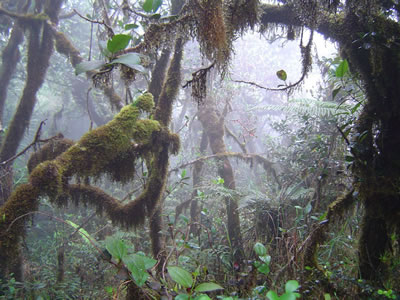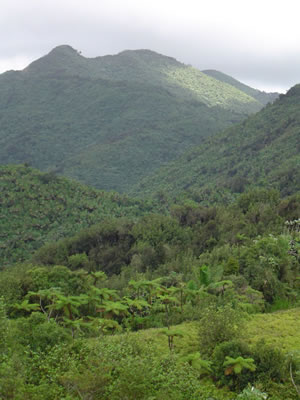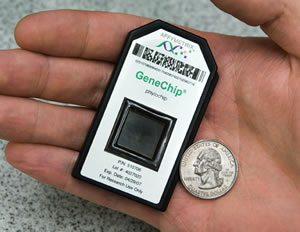Biodiversity of Micoorganisms Key to Advanced Biofuels
By Lynn Yarris
When it comes to biodiversity, microorganisms, or microbes, as they’re more commonly known, rule. So-named for their microscopic size and consisting of bacteria, fungi, archaea and certain plants and animals, such as algae and plankton, microbes are ubiquitous to the biosphere, their presence effusive in every known ecosystem. This is no surprise considering microbes were not only the first forms of life on earth but, for most of our planet’s history, they were the only live show in town. Microbes laid the foundation for the evolution of all other life on earth and they continue to be our planet’s most important residents. From making possible the carbon cycle that feeds plants and produces oxygen, to fixing atmospheric nitrogen into a form the rest of us can use, to decomposing the dead, microbes perform the chemistry that is essential to existence. Without microbes doing what they do, earth’s ecosystems would collapse and its biosphere would die.

Tropical forest soils are among the oldest on Earth and among the poorest nutrients. Microbial communities in these soils have evolved to extract as much carbon out of dead biomass and as quickly as possible. The results are rapid
and complete decomposition. (Photo by Kristen DeAngelis)
Microbes perform their essential chemistry with the help of the enzymes they produce. Enzymes are biomolecules (mostly proteins) that catalyze chemical reactions, meaning they speed up or slow down the rate of the reaction without themselves being affected. Microbial enzymes have played a central role in the decomposition of organic matter for millions of years and are now poised to play a central role in the development of the next generation of biofuels – liquid transportation fuels derived from lignocellulosic biomass that can replace gasoline on a gallon-for-gallon basis.
Sometimes referred to as “grassoline,” advanced biofuels not only release comparable amounts of energy to gasoline, but can also be used in today’s combustion engines and distributed through today’s gasoline infrastructure. The big and crucial difference is that the combustion of advanced biofuels is carbon-neutral, meaning it does not exacerbate global warming. Furthermore, advanced biofuels are renewable and can be grown in the United States, meaning they would reduce our nation’s dependence on imported oil.
A major impediment towards the commercial production of grassoline is the extraction of fuel-producing sugars from the lignocellulose in the walls of plant cells. A complex matrix of polysaccharides and lignin, a rigid wood-like polymer, lignocellulose is the most abundant organic material on earth and one of the toughest. Millions of years of evolutionary development have gone into preventing lignocellulosic sugars from being removed. Lignin, which forms a protective coating around the sugars, is especially resistant to assault. And yet there are known microbial enzymes that can break-down or “deconstruct” lignin. Some are found in the digestive systems of termites and goats. Others are found in forest floor soils or in industrial composts.

Switchgrass buried at different elevations — from wet, cool mountains to dryer, warmer lowlands — is helping scientists pinpoint the optimum conditions for biomass decomposition. (Photo by Kristen DeAngelis)
Scientists are now searching for microbes that produce enzymes that are even more effective at deconstructing lignocellulose than those we know of today. This effort, along with the parallel effort of finding microbial enzymes that can convert extracted sugars into fuels, has received a major boost through the development of a pair of square-shaped DNA chips, each the size of a quarter and packed with several hundred thousand probes. The development of these two microarray technologies - called the PhyloChip and the MycoChip - was led by researchers with the Lawrence Berkeley National Laboratory (Berkeley Lab).
“PhyloChip can distinguish different species of bacteria and archaea through slight DNA base-pair sequence variations in the 16S rRNA gene, a gene that is essential for protein synthesis and is present in all bacteria and archaea,” says Gary Andersen, a Berkeley Lab microbiologist who was one of the leaders in the PhyloChip and MycoChip development projects. “By targeting unique regions of the 16S rRNA gene sequence in samples, we can identify multiple bacterial and archael species simultaneously.”
The PhyloChip can be used to quickly, accurately and comprehensively detect the presence of up to 30,000 different species of bacteria and archaea in a sample from any environmental source, without the need of culturing. The MycoChip is a similar device that utilizes the 18s and 28s rRNA gene sequences to do the same thing for fungi. With the MycoChip technology, more than 11,000 fungal taxa can be simultaneously identified in a sample.
Researchers with the Joint BioEnergy Institute (JBEI), a U.S. Department of Energy Bioenergy Research Center that is a multi-institutional partnership led by Berkeley Lab, have been using the PhyloChip and MicroChip technologies to investigate microbial communities in Puerto Rican tropical rainforest soils that boast some of the planet’s highest rates of biomass degradation. For example, in 2003, just four years after 1989’s Hurricane Hugo devastated Puerto Rico’s east coast, miles of storm-strewn biomass had been completely decomposed.

Berkeley Lab’s PhyloChip can be used to detect the presence of up to 30,000 different species of bacteria and archaea in a sample from any environmental source, without the need of culturing. It is being used for many different purposes, from the development of advanced biofuels to determining the culprit behind the disease that is destroying the coral reef. (Photo by Roy Kaltschmidt)
“The microbial communities present in the tropical rainforest soils of Puerto Rico have optimized the deconstruction of lignocellulose through 40-60 million years of evolutionary selection,” says Terry Hazen, a microbiologist with both Berkeley Lab and JBEI, and world authority on microbes who also played a key role in the development of both the PhyloChip and the MycoChip. “These communities therefore have great potential to provide enzymes with the very high specific activities and rapid kinetics needed for biofuel production.”
Using bags of switchgrass as microbe traps, a research team led by JBEI microbiologist Kristen DeAngelis conducted a census of soil microbes at several sites in Puerto Rico’s Luquillo Experimental Forest to identify the most efficient biomass-degrading bacteria and fungi. In related work, switchgrass and soil communities taken from Luquillo were incubated under different conditions, such as aerobic and anaerobic, to determine the parameters that best drive biomass decomposition. The researchers also began amassing gene inventories of Luquillo’s microbial communities to help pinpoint the enzymes responsible for breaking down lignocellulose.
Says DeAngelis, “Tropical rainforest soils could serve as a reservoir for new biomass-decomposing microorganisms and we’re starting to identify key microbes and enzymes.”
In 2008, Berkeley Lab’s PhyloChip won a prestigious R&D 100 Award from R&D Magazine R&D Magazine’s for being one of the 100 most significant proven technological advances of the year. That same year, it received the bronze medal in the Wall Street Journal Technology Innovation Awards competition.
Additional Information
- For more information about the PhyloChip, visit the Website at http://cso.lbl.gov/web/clients/techdev/success_stories/articles/phylochip.html
- For more information about the Joint BioEnergy Institute, visit the Website at www.jbei.org
- To read a detailed story on the Puerto Rican rainforest expedition, go here:
http://newscenter.lbl.gov/feature-stories/2009/04/22/rainforests-microbes/ - The PhyloChip is also being used to determine what is killing the world’s coral reefs. Read that story here:
http://newscenter.lbl.gov/feature-stories/2009/02/02/coral-reefs/ - For more on the national celebration of the Year of Science go here.


